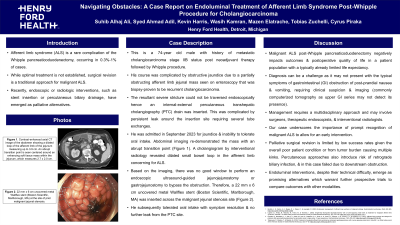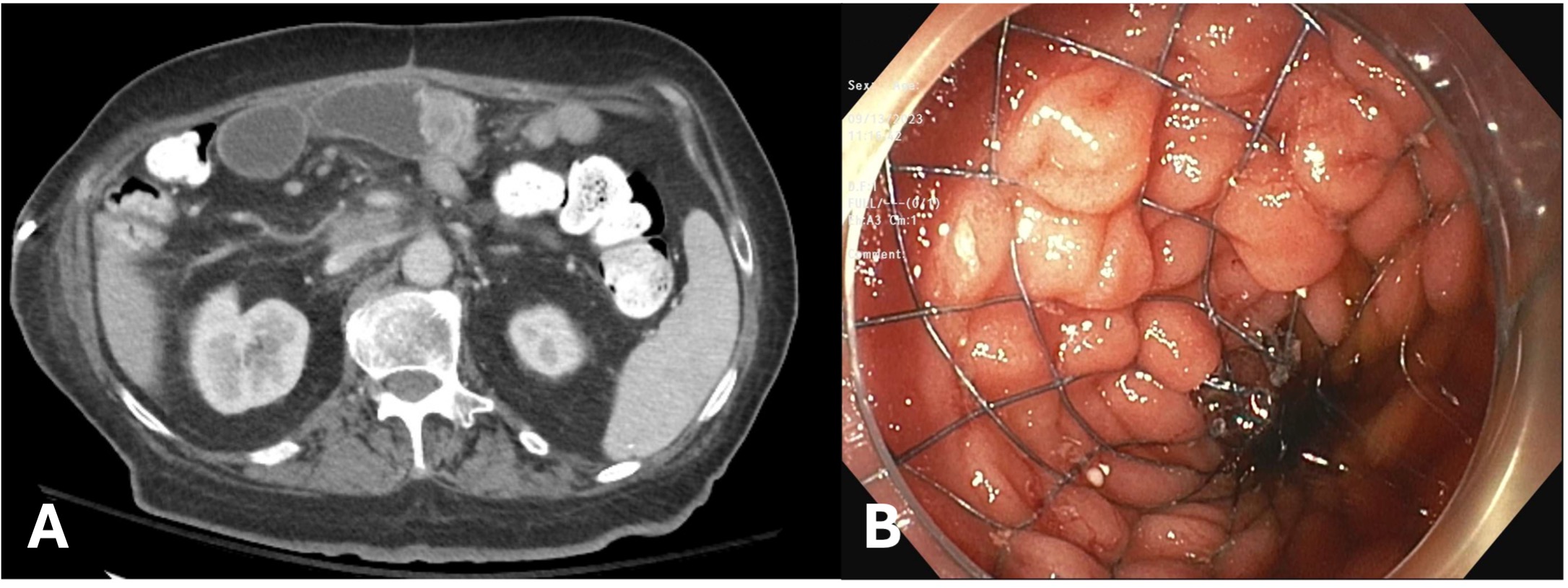Sunday Poster Session
Category: Interventional Endoscopy
P1093 - Navigating Obstacles: A Case Report on Endoluminal Treatment of Afferent Limb Syndrome Post-Whipple Procedure for Cholangiocarcinoma
Sunday, October 27, 2024
3:30 PM - 7:00 PM ET
Location: Exhibit Hall E

Has Audio

Suhaib Alhaj Ali, MD
Henry Ford Hospital
Detroit, MI
Presenting Author(s)
Suhib Alhaj Ali, MD1, Syed Ahmad Adil, MD2, Kevin Harris, MD1, Wasih Kamran, MD1, Mazen Elatrache, MD3, Tobias Zuchelli, MD1, Cyrus Piraka, MD2
1Henry Ford Hospital, Detroit, MI; 2Henry Ford Health, Detroit, MI; 3Henry Ford Health, Dearborn, MI
Introduction: Afferent limb syndrome (ALS) is a rare complication of the Whipple pancreaticoduodenectomy (0.3%-1%). While optimal treatment is not established, surgical revision is a traditional approach for malignant ALS. Recently, endoscopic or radiologic interventions, such as stenting or percutaneous biliary drainage, have emerged as palliative alternatives.
Case Description/Methods: This is a 74-year old male with history of metastatic cholangiocarcinoma stage IIB status post neoadjuvant therapy followed by Whipple procedure. Course was complicated by obstructive jaundice due to partially obstructing afferent limb jejunal mass seen on enteroscopy, biopsy-proven to be recurrent cholangiocarcinoma. The resultant severe stricture could not be traversed endoscopically hence an internal-external percutaneous transhepatic cholangiography (PTC) drain was inserted, complicated by persistent leak around the insertion site requiring several tube exchanges. He was later admitted for jaundice & poor oral intake. Abdominal imaging re-demonstrated the mass with an abrupt transition point (Fig. 1A). A cholangiogram revealed dilated small bowel loop in the afferent limb concerning for ALS. Based on imaging, there was no good window for an endoscopic ultrasound-guided jejuno- or gastrojejunostomy to bypass the obstruction. Therefore, a 22 mm x 6 cm uncovered metal Wallflex stent (Boston Scientific, Marlborough, MA) was inserted across the site (Fig. 1B), which improved his symptoms & oral intake without further PTC leaks.
Discussion: Malignant ALS post-Whipple negatively impacts outcomes & quality of life in a population with already limited life expectancy. Diagnosis can be a challenge as it may not present with typical gastrointestinal (GI) obstruction symptoms, requiring clinical suspicion & imaging (commonly computerized tomography as upper GI series may not detect its presence). Management requires a multidisciplinary approach with surgeons, therapeutic endoscopists, &/or interventional radiologists. Our case underscores the importance of prompt recognition to allow for an early intervention. Palliative surgical revision is limited by low success rates given overall poor patient condition or from tumor burden causing kinks. Percutaneous approaches introduce risk of retrograde biliary infection, & in this case failed due to downstream obstruction. Endoluminal interventions, despite technical difficulty, emerge as promising alternatives which warrant further prospective trials comparing outcomes with other modalities.

Disclosures:
Suhib Alhaj Ali, MD1, Syed Ahmad Adil, MD2, Kevin Harris, MD1, Wasih Kamran, MD1, Mazen Elatrache, MD3, Tobias Zuchelli, MD1, Cyrus Piraka, MD2. P1093 - Navigating Obstacles: A Case Report on Endoluminal Treatment of Afferent Limb Syndrome Post-Whipple Procedure for Cholangiocarcinoma, ACG 2024 Annual Scientific Meeting Abstracts. Philadelphia, PA: American College of Gastroenterology.
1Henry Ford Hospital, Detroit, MI; 2Henry Ford Health, Detroit, MI; 3Henry Ford Health, Dearborn, MI
Introduction: Afferent limb syndrome (ALS) is a rare complication of the Whipple pancreaticoduodenectomy (0.3%-1%). While optimal treatment is not established, surgical revision is a traditional approach for malignant ALS. Recently, endoscopic or radiologic interventions, such as stenting or percutaneous biliary drainage, have emerged as palliative alternatives.
Case Description/Methods: This is a 74-year old male with history of metastatic cholangiocarcinoma stage IIB status post neoadjuvant therapy followed by Whipple procedure. Course was complicated by obstructive jaundice due to partially obstructing afferent limb jejunal mass seen on enteroscopy, biopsy-proven to be recurrent cholangiocarcinoma. The resultant severe stricture could not be traversed endoscopically hence an internal-external percutaneous transhepatic cholangiography (PTC) drain was inserted, complicated by persistent leak around the insertion site requiring several tube exchanges. He was later admitted for jaundice & poor oral intake. Abdominal imaging re-demonstrated the mass with an abrupt transition point (Fig. 1A). A cholangiogram revealed dilated small bowel loop in the afferent limb concerning for ALS. Based on imaging, there was no good window for an endoscopic ultrasound-guided jejuno- or gastrojejunostomy to bypass the obstruction. Therefore, a 22 mm x 6 cm uncovered metal Wallflex stent (Boston Scientific, Marlborough, MA) was inserted across the site (Fig. 1B), which improved his symptoms & oral intake without further PTC leaks.
Discussion: Malignant ALS post-Whipple negatively impacts outcomes & quality of life in a population with already limited life expectancy. Diagnosis can be a challenge as it may not present with typical gastrointestinal (GI) obstruction symptoms, requiring clinical suspicion & imaging (commonly computerized tomography as upper GI series may not detect its presence). Management requires a multidisciplinary approach with surgeons, therapeutic endoscopists, &/or interventional radiologists. Our case underscores the importance of prompt recognition to allow for an early intervention. Palliative surgical revision is limited by low success rates given overall poor patient condition or from tumor burden causing kinks. Percutaneous approaches introduce risk of retrograde biliary infection, & in this case failed due to downstream obstruction. Endoluminal interventions, despite technical difficulty, emerge as promising alternatives which warrant further prospective trials comparing outcomes with other modalities.

Figure: Fig. 1. A: Contrast-enhanced axial CT image of the abdomen showing a dilated loop of the afferent limb of the jejunum measuring up to 3.9 cm. An abrupt transition point is seen centered around an enhancing soft tissue mass within the jejunum, which measures 2.7 x 2.0 cm. B: 22 mm x 6 cm uncovered metal Wallflex stent (Boston Scientific, Marlborough, MA) at the site of prior malignant jejunal stenosis.
Disclosures:
Suhib Alhaj Ali indicated no relevant financial relationships.
Syed Ahmad Adil indicated no relevant financial relationships.
Kevin Harris indicated no relevant financial relationships.
Wasih Kamran indicated no relevant financial relationships.
Mazen Elatrache indicated no relevant financial relationships.
Tobias Zuchelli: Boston Scientific – Consultant.
Cyrus Piraka: Aries and US Endoscopy – Grant/Research Support. NIH – Grant/Research Support.
Suhib Alhaj Ali, MD1, Syed Ahmad Adil, MD2, Kevin Harris, MD1, Wasih Kamran, MD1, Mazen Elatrache, MD3, Tobias Zuchelli, MD1, Cyrus Piraka, MD2. P1093 - Navigating Obstacles: A Case Report on Endoluminal Treatment of Afferent Limb Syndrome Post-Whipple Procedure for Cholangiocarcinoma, ACG 2024 Annual Scientific Meeting Abstracts. Philadelphia, PA: American College of Gastroenterology.
